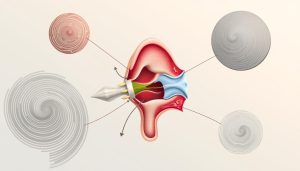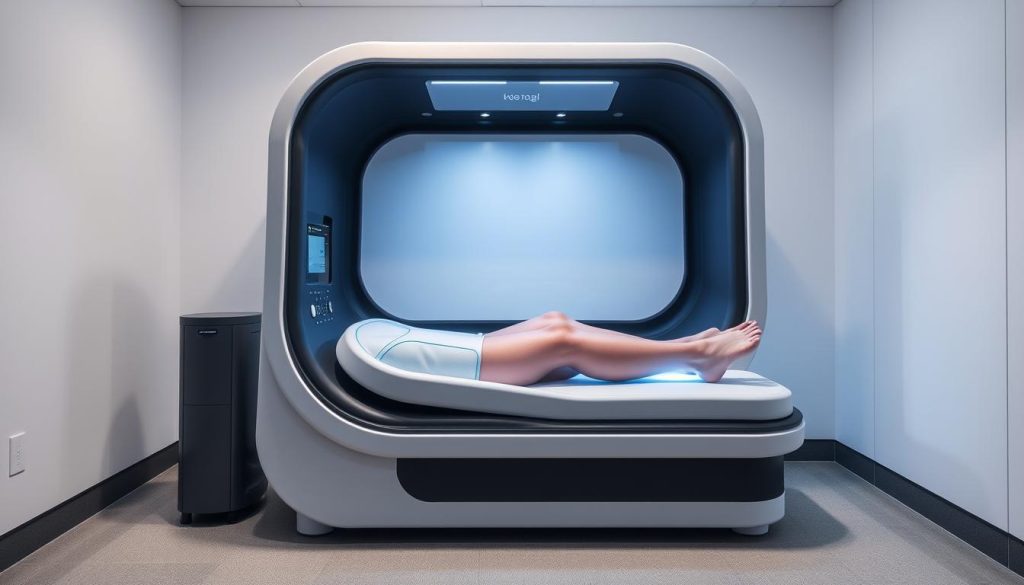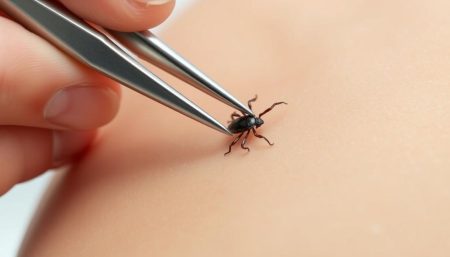After knee surgery, it’s important to recover well to move easily and feel less pain. An ice machine is a big help in this. It cools the area where you had surgery better than ice packs.
Cold therapy is a key part of getting better after knee surgery. It helps by making blood vessels smaller, which slows down pain and swelling. This guide will show you how to use an ice machine, its benefits, and tips for healing well.
Using a cold therapy unit regularly can help you recover faster and manage pain better. This guide will give you important tips on using ice therapy after knee surgery.
Understanding Ice Machine Therapy for Knee Surgery Recovery
Ice machine therapy is key in cooling the knee after surgery. It uses a special device to keep the area cold. This helps the knee heal faster and eases pain.
How Cold Therapy Promotes Healing
Cold therapy tightens blood vessels. This reduces swelling and inflammation. It also slows down pain signals to the brain.
As a result, patients feel less pain and can move more easily while they recover.
Benefits of Continuous Cooling
Continuous cooling has many benefits over ice packs:
- It keeps the temperature steady
- It can be used for longer
- It targets the surgical area
- It’s safer for the skin
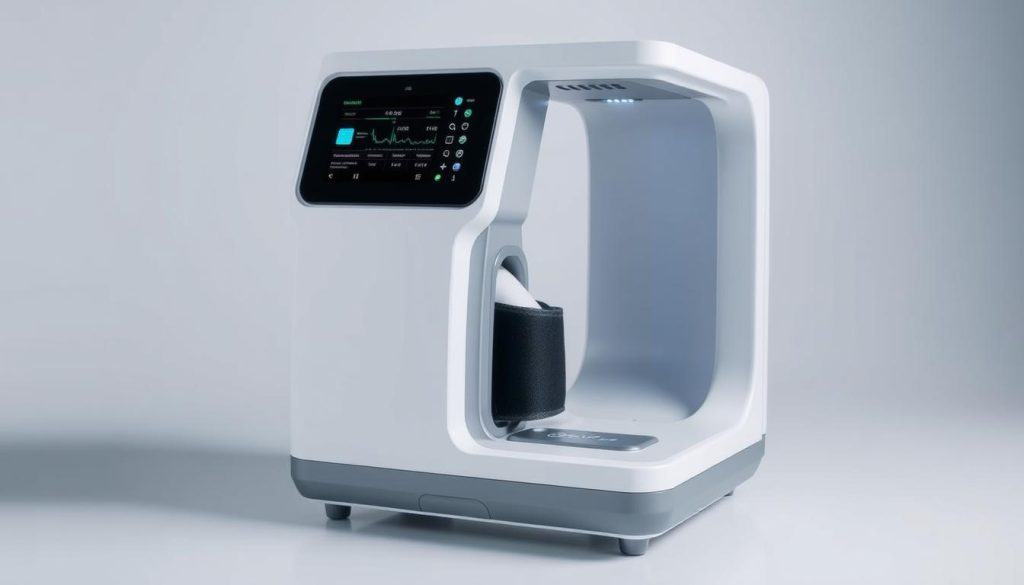
Scientific Evidence Supporting Cryotherapy
Studies show cryotherapy helps knee recovery after surgery. A study in the Journal of Orthopaedic Surgery found:
| Outcome | Improvement |
|---|---|
| Pain reduction | 45% decrease |
| Swelling reduction | 32% decrease |
| Range of motion | 28% increase |
| Recovery time | 20% faster |
These results show how important cryotherapy is for knee surgery recovery. It’s a key part of modern care.
Types of Ice Machines for Knee Surgery
Ice machines are key for knee surgery recovery. They come in different types to meet various needs. Let’s look at the options to help you pick the best portable ice therapy system for your recovery.
Portable Cold Therapy Units
Portable units are small and easy to carry. They’re great for use at home and on the go. These systems have a cooler, a pump, and a knee pad. They’re effective in reducing swelling and pain after surgery.
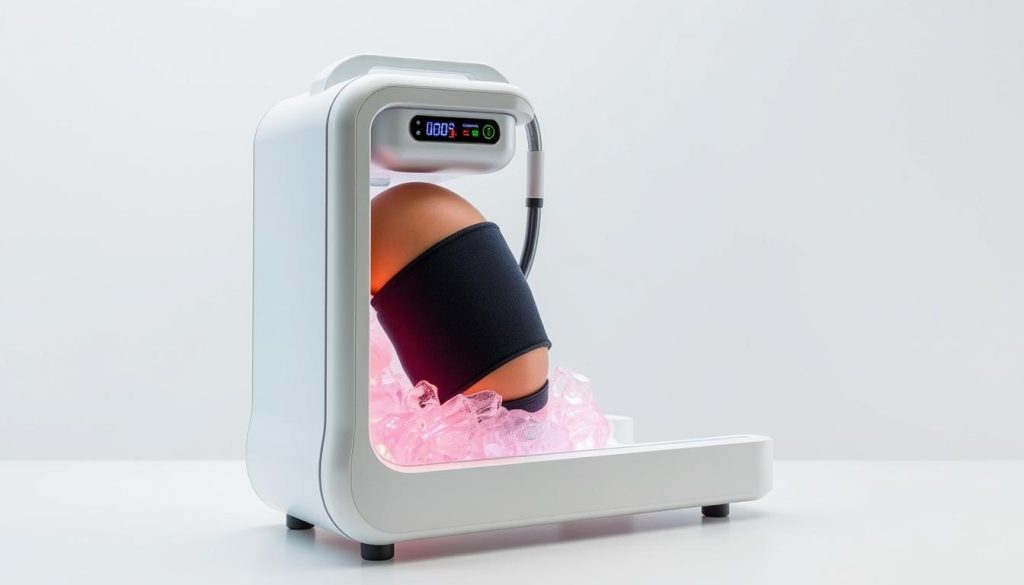
Professional-Grade Systems
Professional-grade ice machines are bigger and found in medical settings. They control temperature well and keep the cold longer. Though they’re not as portable, they have advanced features for better recovery.
Battery-Operated vs. Electric Models
Choosing between battery-operated and electric models depends on your lifestyle and needs. Battery-operated units are more mobile but run out of power sooner. Electric models keep going but need a plug.
| Feature | Battery-Operated | Electric |
|---|---|---|
| Portability | High | Moderate |
| Runtime | Limited | Continuous |
| Power Source | Rechargeable Battery | Wall Outlet |
| Best For | Travel, Outdoor Use | Home, Extended Use |
Choosing the right ice machine ensures you have a reliable aid for your knee surgery recovery.
Immediate Post-Operative Care with Cold Therapy
Cold therapy is key for reducing knee swelling and managing pain after surgery. The first 24-48 hours are critical for recovery. Using an ice machine for knee surgery during this time can greatly aid your healing.
Doctors usually suggest cold therapy for 20-30 minutes every 2-3 hours. This helps control pain and swelling well. Always follow your surgeon’s specific advice, as it may differ based on your situation.
Cold therapy is a game-changer in post-operative care. It’s like pressing a reset button on inflammation and pain.
Here’s a sample schedule for the first 48 hours:
| Time | Duration | Purpose |
|---|---|---|
| Every 2 hours | 20 minutes | Pain relief |
| Before physical therapy | 30 minutes | Reduce stiffness |
| After exercises | 25 minutes | Minimize swelling |
Consistency is important. Regular cold therapy use can improve your recovery. Always watch for skin irritation and adjust treatment as needed.
Selecting the Right Ice Machine for Knee Surgery
Choosing the right ice machine for knee surgery recovery is key for healing. This guide will help you pick the best one for your needs.
Essential Features to Consider
When choosing an ice machine for knee surgery, look for these important features:
- Adjustable temperature settings
- Programmable timer
- Comfortable and secure knee wrap
- Quiet operation
- Portability for ease of use
Price Range and Insurance Coverage
Ice machines for knee surgery cost between $150 and $500. More expensive models have extra features. Check with your insurance about coverage. Some plans may help pay for it, if your doctor prescribes it.
Rental vs. Purchase Options
Renting an ice machine can save money for short-term use. But, buying might be better for long-term needs or frequent use. Think about your needs and budget when choosing.
| Option | Pros | Cons |
|---|---|---|
| Rental | Lower upfront cost, No maintenance | Limited time, Possible availability issues |
| Purchase | Long-term availability, Cost-effective for extended use | Higher initial investment, Maintenance responsibility |
By considering these points, you can find the perfect ice machine for your knee surgery recovery. This will help you heal comfortably and effectively.
Setting Up Your Cold Therapy System
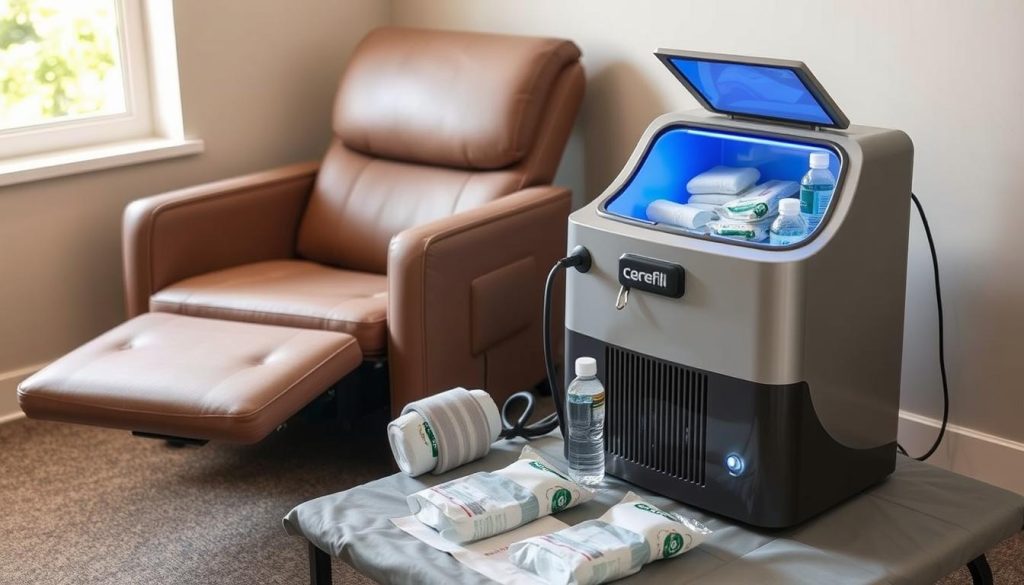
Setting up your cold therapy unit is key for a good recovery. Here’s how to use it right:
- Clean your hands before touching the equipment.
- Fill the reservoir with clean, cold water and ice, following the instructions.
- Connect the cooling pad to the main unit, making sure it fits well.
- Place the cooling pad on your knee, covering the surgical area fully.
- Use the straps to secure the pad, but not too tight.
- Turn on the unit and set the temperature as your doctor advises.
It’s important to place the cooling pad correctly. Make sure it covers both sides of your knee for the best treatment.
| Common Setup Issues | Troubleshooting Tips |
|---|---|
| Leaking connections | Check and tighten all tube connections |
| Insufficient cooling | Add more ice to the reservoir |
| Uneven cooling distribution | Reposition the pad for better coverage |
Always clean your cold therapy unit every day to keep it hygienic. Empty and dry the reservoir after each use to stop bacteria from growing. By following these steps, you’ll get the most out of your knee cooling treatment.
Optimal Treatment Duration and Frequency
Using a cryotherapy device right is key for ACL surgery recovery. Knowing the best treatment time and how often to use it can help a lot. Let’s look at the best plans for each recovery stage.
First 48 Hours Protocol
In the first 48 hours after surgery, cold therapy is very important. Use the cryotherapy device for 20-30 minutes every 2 hours when you’re awake. This helps control pain and swelling during the most important recovery time.
Week One Recovery Schedule
After the first 48 hours, change your cryotherapy plan. Use it for 15-20 minutes, 3-4 times a day. This keeps cold therapy’s benefits while letting tissues warm up, helping healing.
| Time | Duration | Frequency |
|---|---|---|
| First 48 hours | 20-30 minutes | Every 2 hours (while awake) |
| Week One | 15-20 minutes | 3-4 times daily |
Long-term Usage Guidelines
After the first week, keep using the cryotherapy device as needed. Usually, 2-3 times a day for 15 minutes each is enough. Always check with your doctor to make the plan fit your recovery needs.
Remember, cold therapy is good, but don’t forget other recovery steps. Slowly cut back on cold therapy as your knee gets better and you move through physical therapy.
Managing Pain and Swelling with Cryotherapy
Cryotherapy is key for reducing knee swelling and managing pain after surgery. It works by applying cold to the area. This numbs pain and slows down inflammation.
To get the most from cold therapy, position is important. Keep your leg up while using the ice machine. This combo boosts anti-inflammatory effects, speeding up recovery.
Here’s how to use cryotherapy for pain after knee surgery:
- Apply cold therapy for 15-20 minutes at a time
- Wait at least 2 hours between sessions
- Use a barrier between your skin and the ice pack to prevent frostbite
- Continue treatment for several days or as directed by your doctor
Cold therapy is great with prescribed meds. It can cut down on pain reliever use. But, always check with your doctor before changing your meds.
“Cryotherapy is a cornerstone of post-operative care, providing natural pain relief and reducing swelling without the side effects of medications.”
While cryotherapy is good for swelling, it’s part of a bigger recovery plan. Add rest, gentle exercises, and follow-up visits for the best healing after surgery.
Combining Ice Therapy with Physical Rehabilitation
Using ice therapy with physical rehab is a strong knee surgery recovery aid. It helps the healing process and lessens pain. A good plan can greatly help patients after knee arthroscopy.
Coordinating with Physical Therapy Sessions
Timing is key when mixing ice therapy with physical therapy. Cold therapy before therapy can lessen pain and swelling. This makes exercises more effective. After therapy, icing helps with swelling from the exercises.
- Pre-session icing: 15-20 minutes before therapy
- Post-session icing: 20-30 minutes after exercises
- Communication with therapist: Discuss ice machine usage
Home Exercise Integration
Adding ice therapy to home workouts boosts knee arthroscopy recovery. A planned routine helps keep progress steady and avoid setbacks.
| Exercise Type | Ice Therapy Timing | Duration |
|---|---|---|
| Range of Motion | After exercises | 20 minutes |
| Strength Training | Before and after | 15 minutes each |
| Balance Exercises | After completion | 15-20 minutes |
By sticking to these tips, patients can make their recovery routine better. They can balance physical therapy with cryotherapy for the best results.
Safety Precautions and Best Practices
Using an ice machine for knee surgery recovery needs careful attention to safety. Proper use of a cryotherapy device can help healing, but misuse can cause problems.
To avoid skin damage, use a thin barrier between your skin and the cold pad. Limit each treatment to 20 minutes, letting your skin warm up in between. Watch for signs of frostbite, like numbness or skin color changes.
Keep your ice machine clean to avoid infections. Clean it often, following the maker’s guide. Wash your hands before using the device or touching the surgical area.
- Check skin condition frequently
- Keep the treatment area dry
- Use only clean, fresh water in the device
- Replace pads as recommended
If you feel more pain, swelling, or unusual symptoms, stop using the ice machine and talk to your doctor. Always follow your surgeon’s specific cold therapy use after knee surgery.
| Do | Don’t |
|---|---|
| Use a barrier between skin and cold pad | Apply ice directly to skin |
| Limit sessions to 20 minutes | Exceed recommended treatment time |
| Clean device regularly | Neglect hygiene practices |
| Monitor skin condition | Ignore signs of frostbite |
Common Mistakes to Avoid During Treatment
Using a cold therapy unit can help you recover faster after knee surgery. But, it’s important to avoid common mistakes. Let’s look at some errors patients often make and how to avoid them.
Temperature Control Errors
Getting the temperature right on your cold therapy unit is key. If it’s too cold, you might hurt your skin. If it’s too warm, you won’t get the best results. Aim for a temperature between 50-55°F for the best knee cooling.
Duration Miscalculations
Using your cold therapy unit too much can be bad. Follow your doctor’s advice, usually 20-30 minutes every 2-3 hours. Don’t fall asleep with it on, as it can damage tissues.
Improper Pad Placement
Putting the pad in the right place is important. Cover the whole surgical area but not stitches or cuts. Use a thin layer between your skin and the pad to avoid frostbite.
Your cold therapy unit is a powerful tool for recovery. By avoiding these mistakes, you’ll get the most out of it. This will help you heal faster after knee surgery.
Recovery Milestones and Progress Tracking
Tracking your progress after knee surgery is key for a good recovery. Using a knee surgery recovery aid like an ice machine can really help. Let’s look at important milestones and how to track your improvement.
Keep a recovery journal to track your daily experiences. Write down your pain levels, how well you can move, and any swelling changes. This journal helps you and your healthcare provider see how you’re doing over time.
For ACL surgery recovery, you’ll see slow but steady gains in mobility and strength. Here’s a general timeline of milestones:
| Time Post-Surgery | Expected Milestone |
|---|---|
| 1-2 weeks | Reduced swelling, improved knee extension |
| 2-4 weeks | Increased weight-bearing, better flexion |
| 4-6 weeks | Walking without crutches, light exercises |
| 2-3 months | Return to low-impact activities |
| 6-9 months | Gradual return to sports |
As you get better, adjust how often you use your ice machine. Start with it often to control pain and swelling. Then, use it less as your knee heals. Always talk to your healthcare provider about any changes or worries to make sure you’re recovering right.
Maintenance and Cleaning of Your Ice Machine
Keeping your portable ice therapy system clean is key for its long life and your health. Regular care makes sure your ice machine for knee surgery works well during your recovery.
Daily Cleaning Procedures
Every day, clean your ice machine to stop bacteria from growing. Empty the water tank and dry it with a clean cloth. Use a mild soap to clean the tubing and cooling pad, then rinse well and let them air dry.
Long-term Maintenance Tips
For the best results, descale your ice machine every month. Use a mix of water and white vinegar, then rinse with clean water. Also, change filters as the maker suggests, usually every 3-6 months. Store your ice machine in a cool, dry spot when not using it to avoid mold.
- Check for leaks or wear in tubing weekly
- Inspect the cooling pad for damage before each use
- Clean the exterior with a damp cloth to remove dust
By sticking to these maintenance tips, you’ll make your ice machine for knee surgery last longer. It will stay a trusted aid in your recovery.
When to Discontinue Cold Therapy
It’s important to know when to stop using cold therapy on your knee after surgery. As you heal, you’ll see signs that it’s time to cut back or stop using it.
One big sign is when your knee swelling starts to go down. If your knee looks and feels almost normal again, it means the inflammation is getting better. You might also feel less pain and be able to move your knee more easily.
Another sign is when you reach your physical therapy goals. If you’re doing well in your therapy, you might not need as much cold therapy. Talk to your therapist about changing your treatment plan.
| Signs to Reduce Cold Therapy | Action Steps |
|---|---|
| Decreased swelling | Gradually reduce session frequency |
| Improved pain levels | Shorten session duration |
| Better range of motion | Focus on targeted cooling after exercise |
| Meeting PT milestones | Transition to as-needed basis |
To stop using cold therapy, start by doing it less often and for shorter times. You might go from doing it many times a day to once a day, then only after you exercise. Some people find it helps keep their knee healthy for a long time, even after they’ve been active.
Keep in mind, everyone heals differently. Always listen to your doctor about when to stop or change your cold therapy. They can help you make sure your knee heals well and works right.
Alternative and Complementary Recovery Methods
Ice machines are key in managing pain after knee surgery. But, other methods can also help. For example, compression therapy reduces swelling and boosts blood flow. Heat therapy can relax muscles and improve flexibility later on.
Transcutaneous electrical nerve stimulation (TENS) is a drug-free pain relief option. It uses electrical currents to block pain signals. Many people use TENS with cold therapy for better comfort.
Nutrition and sleep are also important for healing. Eating foods rich in protein and vitamins helps repair tissues. Good sleep lets the body focus on recovery. Talk to your doctor about these options to make a recovery plan that works for you.
Every recovery is different. What helps one person might not work for another. Always check with doctors before trying new recovery methods. They can help you find safe and effective ways to speed up your healing.
FAQ
Q: How long should I use an ice machine after knee surgery?
A: The time you use an ice machine depends on your surgery and recovery. Most people use it most in the first 1-2 weeks. Then, they use it less over the next 4-6 weeks. Always listen to what your doctor says.
Q: Can I sleep with the ice machine on?
A: It’s best not to run the ice machine all night. Use it for 20-30 minutes at a time during the day. Talk to your doctor about using it at night.
Q: How cold should the ice machine be set for knee surgery recovery?
A: Ice machines are set to safe temperatures, usually 45°F to 55°F. Never go below 40°F to avoid skin damage. Always follow the maker’s and your doctor’s advice.
Q: Can I use an ice machine for both knees if I’ve had bilateral knee surgery?
A: Yes, some machines have dual pads for both knees. If you’ve had surgery on both, ask your doctor about using one for both knees.
Q: How often should I change the water in my ice machine?
A: Change the water every day for best hygiene and performance. Some machines have special care, so always check the maker’s guide.
Q: Is it normal to feel numbness when using an ice machine?
A: A little numbness is okay, but too much is not. If you feel too numb, try using it less or at a lower temperature. Talk to your doctor.
Q: Can I use an ice machine for knee replacement recovery?
A: Yes, ice machines help with knee replacement recovery. They can reduce pain and swelling. Just follow your surgeon’s advice.
Q: How do I clean the pad of my ice machine?
A: Clean the pad with mild soap and water after each use. Let it air dry. Some pads can be washed gently. Always check the maker’s guide for cleaning.
Q: Can I use an ice machine for other types of injuries beside knee surgery?
A: Ice machines are mainly for knee surgery, but they can also help with other injuries. Talk to your doctor to see if it’s right for you.
Q: Is renting an ice machine more cost-effective than buying one?
A: Renting might be cheaper for short-term use, up to 2-3 weeks. Buying is better for longer use or future needs. Think about your insurance and health needs.











